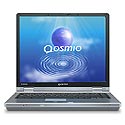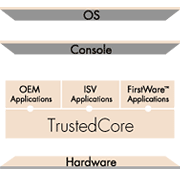Windows media laptop plays with embedded Linux
Jul 22, 2004 — by LinuxDevices Staff — from the LinuxDevices Archive — 2 views [Updated July 23, 2004] — Toshiba today launched a laptop that is widely rumored to offer the choice of booting Windows Media Center Edition 2004, for full PC capabilities, or a quick-starting embedded Linux environment, for instant-on, appliance-like TV tuner, DVD player, CD player, and remote control capabilities. Toshiba is selling the Qosmio laptop direct in the US, priced at $2,699.
[Updated July 23, 2004] — Toshiba today launched a laptop that is widely rumored to offer the choice of booting Windows Media Center Edition 2004, for full PC capabilities, or a quick-starting embedded Linux environment, for instant-on, appliance-like TV tuner, DVD player, CD player, and remote control capabilities. Toshiba is selling the Qosmio laptop direct in the US, priced at $2,699.
(Click for larger view of Toshiba Qosmio)
Fast startup and shutdown times are among the most important considerations for embedded operating systems in consumer electronic (CE) devices. Toshiba says the Qosmio can function as a CE media device within ten seconds of pushing the power button. Since Windows can't do that, they apparently turned to Linux.
Toshiba would not comment on the pre-boot media environment used in the Qosmio, but it appears similiar to an off-the-shelf media player environment from InterVideo called “InstantOn.” InterVideo also claims boot times under 10 seconds for its media technology, which is based on embedded Linux.
InterVideo launched InstantOn last January, and has since licensed it for use in the AOpen barebones PC, NEC ValueStar PCs, LaVie PCs, Hitachi Prius PCs, and Fujitsu Notebooks. InterVideo VP of Marketing Mike Ling said Toshiba did not license InstantOn for use in Qosmio, however.
 Another possibility is that the Qosmio's media environment is based on technology similar to BIOS vendor Phoenix's “Core System Software” (CSS), a term the company hopes will catch on in describing a class of firmware and applications that run below the OS level. The diagram at the left illustrates how various CSS applications can run in a “pre-boot” environment, without requiring the PC's OS to be loaded. CSS applications might include system recovery tools, which can be built into a PC to provide a diagnostics and repair utility, instant access to email, contacts, and to-do lists, and functions such as those attributed to the Toshiba Qosmio laptop's instant-on TV and media player functions.
Another possibility is that the Qosmio's media environment is based on technology similar to BIOS vendor Phoenix's “Core System Software” (CSS), a term the company hopes will catch on in describing a class of firmware and applications that run below the OS level. The diagram at the left illustrates how various CSS applications can run in a “pre-boot” environment, without requiring the PC's OS to be loaded. CSS applications might include system recovery tools, which can be built into a PC to provide a diagnostics and repair utility, instant access to email, contacts, and to-do lists, and functions such as those attributed to the Toshiba Qosmio laptop's instant-on TV and media player functions.
Laptop specs
The Qosmio uses a Mobile Pentium 735 processor clocked at 1.7GHz and featuring 2MB of L2 cache and a 400MHz frontside bus. It comes with 512MB of DDR SDRAM, and supports 2GB of RAM through two SO-DIMM slots. It also includes an 80MB hard drive, DVD+/-R drive, and an integrated 720×480 TV tuner.
According to Toshiba, Qosmio uses a special screen technology, dubbed “TruBrite,” that when operating on AC power, puts out 600 nits, a measure of luminance that compares to the screens found in LCD TVs (the display dims to 379 nits under battery power). Brightness can be adjusted with physical Fn buttons. The Qosmio's 15-inch XGA (1024 x 768, 65K colors) display features 120-degree horizontal and 90-degree vertical viewing angles, and a claimed contrast ratio of 450:1. The Qosmio can also be attached to larger TV display screens through rear-panel mounted S-video and component out D port connectors. The laptop uses Intel's 855PM chipset, along with an Nvidia GeForce FX Go 5200 graphics chipset and an AnalogDevices AD1981B sound chip.
Additional I/O ports and features include:
- 4 USB
- RGB monitor out
- Software V.92 fax/modem with RJ11 port
- Intel Pro/100 VE Ethernet with RJ45 port
- Intel Pro/Wireless LAN 2200 BG mini-PCI adapter
- Bluetooth 1.1
- i.Link 1394 (FireWire)
- S/P DIF shared with headphone jack
- 2 AV IN ports: S-Video in and composite/monitor/line in
- Coaxial antenna connector
- PCMCIA slot supporting 1 type II card
- Bridge Media Adapter supporting SD, Memory Stick, Memory Stick Pro, and xD cards
- CIR receiver supporting remote control, also supports external USB RC-6 IR Blaster for use with Windows
- Touchpad pointing device with hardware Fn button disable
- cable lock slot
The laptop weighs 8.17 pounds, without the 90-watt, 1.4-pound power adapter, and measures 13.31 x 11.22 x 1.7 inches. Claimed battery life from the 6-cell 3600mAh lithium batter is 2.35 hours.
Toshiba has launched a Qosmio.com website for the new laptop.
This article was originally published on LinuxDevices.com and has been donated to the open source community by QuinStreet Inc. Please visit LinuxToday.com for up-to-date news and articles about Linux and open source.